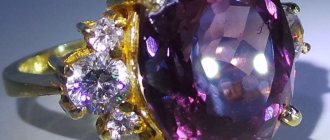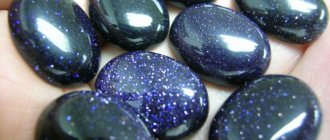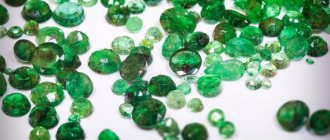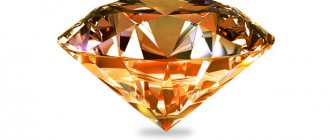A stone that changes color is especially popular in the world of magic and in everyday life. It's time to get acquainted with such nuggets.
Terms
Let's try to figure out the name of a stone that changes color. This phenomenon has several official names:
- Plechroism is the ability of a nugget to change color when a stream of light is reflected in a different direction.
- The Alexandrite effect is a transformation of the color of the mineral in the event of a change in lighting. This same phenomenon is called color reverse. The term is popular in the jewelry industry, where transformation of the color of a stone is possible under artificial lighting conditions. The depth of change is measured as a percentage. The higher the percentage, the more expensive the nugget.
Ordinary people call such stones chameleons.
Tourmaline
This stone comes in different shades and can shimmer in the sun and under artificial light. It looks good in silver and gold settings, so it is more often found in jewelry than in inexpensive costume jewelry. Ancient beliefs believe that this stone symbolizes:
- spiritual search;
- wisdom;
- faith;
- goodness and light.
In nature, this stone can have different shapes, but jewelers most often cut the crystal in the form of an elongated prism with a sharp end. In nature, it is possible to find tourmaline of a brown-red hue, which, when heated and changing the viewing angle, changes color to olive green. There are also stones of other shades.
This mineral has healing properties:
- normalization of metabolism;
- restoration of normal blood pressure;
- balances the psycho-emotional state.
It is believed that this crystal has powerful energy that can neutralize negative effects, give good luck in the financial sphere and restore lost energy. Due to its strong influence, the stone is not recommended for weak natures. Esotericists recommend it:
- creative people;
- women dreaming of pregnancy.
For a creative person, this crystal can become a source of inspiration. It activates talent and creative thinking, stimulates brain activity.
Reasons for color change
Chameleon stones are quite rare in nature. Therefore they have special value. Let's look at the main reasons for changing the color of a stone:
- Physics. Minerals are substances made up of chemical elements. One or two substances are the base, and the rest are impurities. The type and percentage of these substances determine the color and basic parameters of the nugget. In nature you can find stones that change color depending on the lighting. In addition, transformation can be observed due to humidity or temperature fluctuations.
- Magic. Supporters of supernatural sciences believe that a change in the color of a stone when worn is a bad sign. The wearer should be wary of illness, trouble, and possibly death. The mineral can be affected by magic or negative mood.
Who is suitable for volatile minerals?
Gemstone minerals are primarily suitable for kind and open people who are able to accept something new into their lives. The stones respond well to positive vibrations from the owner and are all the more willing to give away their positive properties.
When choosing a stone, you can be guided by the compatibility of stones with certain zodiac signs:
- Air signs, which are characterized by an easily excitable nervous system, need to look towards green gems.
- Water people are recommended blue tones, which can give their character more firmness.
- Earthy signs should prefer dark colors, such as black tourmaline, which adds more lightness and fluidity to the owners.
- Hot or fiery people should give preference to fiery colors. They will pacify the violent temper, and also strengthen the positive aspects of character.
Chameleon stones
It's time to get acquainted with precious and semi-precious stones that have the property of color transformation.
Alexandrite
The Imperial Stone can change its color. During the day it looks like an emerald, and in the evening the nugget becomes a ruby. Such properties of the mineral are explained by the category of its crystal lattice, as well as impurities in the form of titanium, chromium and iron. In the daytime, when the intensity of ultraviolet radiation is at its maximum level, chromium becomes the main element, which leads to a change in color from the traditional purple color to green colors with a blue tint.
In the evening there is a lot of infrared radiation, which activates the function of iron. The crystals acquire a crimson color range. Light filters allow you to see alexandrite's orange color with a yellow tint. A more striking effect can be seen under artificial lighting conditions, when the stone takes on a rich ruby color.
The phenomenon of color changes under different lighting is considered a standard, which is why it was called the alexandrite effect.
Agate
The nugget belongs to the category of semi-precious minerals. The stone is capable of changing color due to changes in the well-being and mood of its wearer.
Sultanite
Turkish sultans love this mineral. Jewelry format stones can only be mined in Tertia. There are several factors influencing the transformation of the color of sultanite. Let's look at each of them in more detail:
- Lighting. In poor lighting conditions, the stone takes on a grassy green color. In bright sunlight, the crystal acquires any shades of yellow, which can vary to reflections of crimson.
- Inclusion. The color of a mineral is influenced to a certain extent by the percentage of impurities contained in its composition.
- Frame or cut options. The stone is combined with platinum or gold of the highest standard. Other framing options may cause the stone to appear dull.
Sultanite has a richer and brighter range of colors than alexandrite.
Amethyst
The jewelry type of quartz is also a chameleon. The stone receives similar characteristics due to iron and aluminum or manganese, which are its components. The nugget has a full spectrum of blue shades - from lilac blue to dark violet colors. Amethyst is a stone that changes color depending on temperature or light:
- If the mineral is heated, it will begin to turn pale. The traditional purple color will be replaced by yellow paints or shades of green. When temperatures reach more than 250 degrees Celsius, the stone becomes colorless. In addition, the nugget changes color, not reacting to the body temperature of the wearer.
- Daytime amethyst manifests itself in the presence of natural light. With a lack of light or when replacing it with an artificial similar crystal, it begins to fade and turn pale. At the same time, these phenomena give night amethyst a mysterious shine and shimmer. In nature, night nuggets are quite rare.
Tourmaline
The stone belongs to the category of aluminosilicates that contain boron. The effect of alexandrite is observed in any type of mineral, but the most striking representatives of chameleons are two nuggets.
When exposed to artificial light, the pink crystal acquires deep brown shades, as well as dark green colors with brownish-red shades. The gem draws magical energy from the bright sun.
Topaz
Nuggets of yellow, blue and pink colors have the ability to change color. The crystals are processed, which allows them to be given a rich color. Constant color will be provided by natural or electric lighting, and transformation occurs due to direct exposure to ultraviolet radiation. Yellow stones take on red tints, while blue and pink specimens show discoloration.
Opal
Some types of nuggets are capable of reproducing special optical phenomena - reflections of light in a rainbow format can emanate from their surface. Such transformations are called opalescence. The most famous in this direction are gems mined in Mexico. The play of color in these minerals resembles an internal flame.
Opal is a stone that changes color with water. In other words, rains or their anticipation, as well as immersion of the mineral in water, lead to the fact that the blue color turns into orange, and the red gem acquires yellow shades.
Moon rock
Transformations correspond to the lunar phases:
- The new moon practically deprives the stone of its shine and milky color.
- The full moon makes the mineral transparent and gives it the ability to glow.
- The waxing moon can cause spot-like white haze.
There is no scientific definition of the phenomenon. Magicians consider the phenomenon to be a manifestation of magical power. An untimely transformation in the color or shine of a moonstone notifies the wearer of approaching danger.
Aquamarine
Beryl, with its bluish-green color palette, is of particular value. Aquamarine can change color due to physical changes or in case of mood swings in the wearer:
- By rotating the gem, you can observe the silver shine emanating from the depths of the crystal. Externally, the phenomenon is similar to chrysanthemum flowers.
- Heating the nugget gives it a thicker, uneven color.
- Long-term exposure to ultraviolet radiation gives aquamarine a yellow color with a brown tint or an earthy color.
- X-rays give the stone the green-blue hue of the mottled specimen.
- The gem interacts with the physical state of the wearer and weather conditions. An increase in green colors means the likelihood of a storm developing or a disorder on the part of the mineral carrier.
Pyrope
The color of one type of garnet is formed due to a combination of manganese, iron and chromium in its composition. The proportion of minerals contributes to the formation of a color palette. Pyrope is often called a barometer of energy:
- A wearer with a strong will and determination has powerful energy, which causes the stone to take on a red tint. This phenomenon means that the owner is energetically charged.
- A weak and lethargic person will wear a dull stone, which will only aggravate the negative condition.
Blue Garnet
The effect of alexandrite is pronounced in blue garnet, which is mined in Madagascar. The mineral changes color throughout the day, which is why it is called a mood stone:
- Sunlight gives the stone a moderate color ranging from blue with gray shades to a dark green palette.
- Artificial light causes the gemstone to acquire red or purple hues.
The color palette for blue garnet can be brighter when the stone is closer to the planet’s equator.
Opal
This stone, with its variability, changes its owners. It should be worn only by righteous and creative people, since in this case it will help them realize their plans. Adventurers by nature, after wearing opal for a long time, can go to great lengths. The stone patronizes Pisces and Scorpios. The uniqueness of opal is that it changes color not only under sunlight, but also when in contact with liquid.
In ancient times, opal was used to treat various ailments:
- consequences of stress;
- infections;
- heart pathologies;
- insomnia.
Healers recommended wearing opal amulets for lovers so that their feelings would be preserved for many years. The crystal also eliminates damage and negative energy. There is a belief that opal should only be worn in pairs. Therefore, an even number of crystals should be used in a piece of jewelry, along with rock crystal and other minerals.
Rules for caring for a chameleon
Precious and semi-precious minerals require compliance with the following rules of care and wearing:
- Store in a closed box where light does not penetrate.
- Contamination is removed with a soap solution, after which the stone is rinsed and wiped with a napkin.
- Abrasives and chemicals are prohibited.
- It is advisable to avoid intense exposure to ultraviolet radiation (sun).
- You can put on the jewelry after you have completed applying makeup and shaping your hair.
- Accessories should be removed before starting housework.
Gems are capable of attracting various energies, so they should be cleaned in running water for 30 minutes. You can sprinkle them with salt and leave for a quarter of an hour. After which the stone is rinsed, and the salt is sent for disposal.
Natural chameleon crystals are a subject of interest for a true connoisseur. Such minerals evoke admiration and become unique magical artifacts. Using such a nugget requires caution. Such stones can be worn by strong personalities. Earrings, brooches or other jewelry with such stones should be in harmony with the selected wardrobe items.
Corundums
This is a whole group of crystals that, to one degree or another, have the property of changing shade. The most famous and durable corundum is diamond, but sapphires and rubies are more prone to discoloration. At the same time, their color reverse appears only in the sun, since heat and ultraviolet participate in the change in shade.
The entire group of corundums also has healing properties. Wearing them allows you to:
- get rid of nightmares;
- balance the psycho-emotional state;
- normalize blood pressure;
- strengthen blood vessels.
Distrustful and mocking people should not wear corundum. They are well suited to strong and bright natures. These stones are perfect for Cancers, Aquarius and Pisces. They are the patrons of these signs. The choice of mineral should also be made based on the profession of the wearer. Diamonds and other corundums are recommended for businessmen, entrepreneurs, and students. They can bring material success and stability to knowledge workers.










